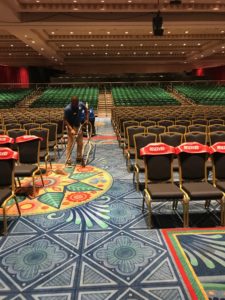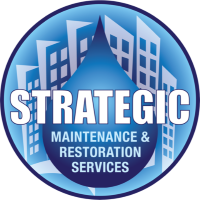What is Strategic Restoration & Maintenance carpet cleaning methods of choice
The carpet cleaning methods and system used depends on several important factors.
- What type of carpet are you cleaning?
- What are the manufactures recommendations?
- How soiled is the carpet?
- How fast can the carpet dry?
- How experienced is the technician?
- How good is the cleaners equipment and cleaning solutions?
What is the carpet cleaning methods or system we recommend?
Depending on the cleaning objective we may use combinations of carpet cleaning methods to customize a system that best meets your needs. (see methods & systems described below) However….
In general:
Heavily soiled carpet, or carpet that is cleaned less than 1 time per year, most likely requires restorative cleaning (pre-vacuum, spot & pre-treat traffic areas followed by a hot water extraction rinse). When professionally done, the use of this hot water carpet cleaning system will rinse your carpet free of soil, oils, food spills, some pet accidents*, air pollutants & harmful microbes. This system is eco friendly, healthy & safe on almost all carpet. Plus it is what the testing by The Carpet & Rug Institute concluded.
Commercial and Residential Maintenance Programs usually include routine cleaning, interim cleaning and restorative cleaning frequencies using multiple cleaning methods and systems.
*Some pet accidents may require specialized cleaning solutions and treatments
Below are some commonly used definitions in the industry:
Cleaning Method
The chemistry and equipment used within a system.
Cleaning System
The implementation of principles, procedures and methods to achieve desired levels of cleaning.
Routine Cleaning
Routine cleaning is performed daily, weekly or more regularly and usually includes vacuuming and timely spot removal.
Interim Cleaning
Interim cleaning is defined as surface/appearance cleaning. It is a highly productive and quick drying process often used between restorative cleaning processes. The frequency of interim cleaning depends on the carpet location, use and exposure to soiling.
Restorative Cleaning
Restorative cleaning is a process of extracting or removing entrapped soils and residues. Restorative processes typically have higher moisture levels, lower production rates and slower drying. Restorative cleaning can be achieved by using both dry and wet cleaning systems. Cleaning frequency depends on the daily maintenance and effectiveness of interim cleaning processes. The frequencies are also determined by the carpet’s location, use, and exposure to traffic and soil.
Dry cleaning cleaning systems use solvents or combination’s of water, detergents and solvents. Many fine fabrics require pure solvent dry cleaning because water may adversely effect it. Dry compound cleaning agents are typically natural or synthetic compounds with detergent carriers. These products usually use less moisture and can be most effective when performing interim (appearance) cleaning or spot cleaning in high traffic, 24 hr use facilities. The correct frequency must be adhered to. Dry compound cleaning products also can assist in reducing slip fall incidences where 24 hr facilities/residences have carpet adjacent to hard surfaces. Note: The only “true” dry soil extraction cleaning method available is your vacuum. It is also the most ECO friendly!!!
***It is important to note that The Carpet and Rug Institute (Seal of Approval) testing of dry compounds reveal that these products remove less soil than SOA Gold rated hot water cleaning systems. By increasing time, mechanical intensity and frequency dry compound results can improve effectiveness. Vacuuming or pile lifting vacuuming is necessary to remove the product after product absorbs/adsorbs spills/soil.
Wet cleaning systems are typically associated with higher levels of water. Water is used as a rinsing agent. Combined with heat and properly specified cleaning products hot water extraction can be quicker and more effective to restore heavy traffic areas or for one time cleanings. According to the Carpet and Rug Institute SOA approved truck mounted and portable hot water extraction units remove more soil than the many other currently tested systems. Hot water can be the most naturally effective restorative cleaning product available. Professionals often will use air movers that reduce down time and enhance drying. Hot water extraction is the most popular cleaning system used for both residential and commercial restorative cleaning.
Minimum (Low) Moisture cleaning systems usually use a reduced amount of moisture. They are usually associated with appearance management or interim maintenance. Cleaning products are typically topically applied and then mechanically distributed using a variety of different systems. Low moisture systems can include dry compounds,foams and encapsulants.
Below are some descriptions of systems commonly used in the industry:
Absorbent/Adsorbent Compound cleaning system
Used in interim & restorative cleaning, this minimum moisture system uses absorbent/adsorbent compounds (cellulosic or polymer based) that are disbursed and agitated into carpets. Cleaning product and soil is extracted by vacuuming or pile lifting machines.
Dry Foam cleaning system
This is a minimum-moisture system used for restorative cleaning. After vacuuming, dense foam is produced through mechanical aeration and distributed via a mechanical brush. The excess foam and suspended soil are extracted by a wet vacuum typically incorporated into the same machine.
Shampoo cleaning system
Used in interim and restorative cleaning systems. Today method typically is not used alone. After vacuuming, this cleaning system uses detergent that is agitated with a mechanical brush, after which both the shampoo and suspended soil should be extracted by either a wet vacuum or dry vacuuming process. Top fed orbital brushes can overwet carpet. Water extraction is sometimes necessary to rinse detergent out. Post vacuuming may also be needed if using encapsulating technology.
Hot Water Extraction cleaning system
This method is used in restorative cleaning. After vacuuming, a cleaning product is applied to the carpet and agitated into carpet fibers with a mechanical or hand held brush. The cleaning product and suspended soil are extracted by rinsing with hot water from a portable or truck-mounted extraction unit, which may contain rinsing agents or emulsifiers.
Encapsulation cleaning system
Used in interim cleaning. After vacuuming, this low moisture, low residue cleaning system sprays down an encapsulating detergent solution followed typically by a counter rotational brush. The solution crystalizes around soil so that it can be easily vacuumed out. These machines lift the pile which helps to free soil from entangled fibers. Vacuuming is recommended after carpet is dry.
Combination cleaning system
Used in restorative cleaning, After vacuuming these systems combine cleaning procedures from different cleaning methods to achieve optimum results.
Bonnet cleaning system
Used in interim cleaning, this minimum moisture method is also called the absorbent pad method. After vacuuming, a detergent solution is applied to the carpet then is transferred onto absorbent pad/bonnet attached to a drive block on a low r.p.m. rotary floor machine.
Note: Many manufacturers do not recommend bonnet cleaning.
